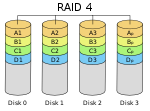简单地说RAID3,5,6的容错原理如下。因为其工作原理不同,在磁盘进行I/O操作时的效率也是不同的。
RAID 3提供一个单独的硬盘来记录奇偶校验值,数据分散地写入数据盘(
条带技术),最少需要3块硬盘,利用率为(n-1)/n,容错能力为一块硬盘。
RAID 5把奇偶校验值和数据分散地写入每块硬盘(
条带技术),在每块硬盘上除了数据以外,还有奇偶校验值-比如A盘记录B盘的校验值,B盘记录C盘的校验值,C盘记录A盘的校验值,最少需要3块硬盘,利用率为(n-1)/n,容错能力为一块硬盘。
RAID 6是RAID3和5的组合,既提供一个单独的硬盘来记录奇偶校验值,同时也把奇偶校验值和数据分散写入其他硬盘(
条带技术),最少需要4块硬盘,利用率为(n-2)/n,容错能力为两块硬盘。
------------------------------
以下是Wikipedia上的描述:
RAID 3
Striped set with dedicated parity or bit interleaved parity or byte level parity. This mechanism provides an improved performance and fault tolerance similar to RAID 5, but with a dedicated parity disk rather than rotated parity stripes. The single parity disk is a bottle-neck for writing since every write requires updating the parity data. .e minor benefit is the dedicated parity disk allows the parity drive to fail and operation will continue without parity or performance penalty.
Minimum # of disks: 3
Space Efficiency: n-1

Striped set with dedicated parity or bit interleaved parity or byte level parity. This mechanism provides an improved performance and fault tolerance similar to RAID 5, but with a dedicated parity disk rather than rotated parity stripes. The single parity disk is a bottle-neck for writing since every write requires updating the parity data. .e minor benefit is the dedicated parity disk allows the parity drive to fail and operation will continue without parity or performance penalty.
Minimum # of disks: 3
Space Efficiency: n-1

RAID 4
Block level parity. Identical to RAID 3, but does block-level striping instead of byte-level striping. In this setup, files can be distributed between multiple disks. Each disk operates independently which allows I/O requests to be performed in parallel, though data transfer speeds can suffer due to the type of parity. The error detection is achieved through dedicated parity and is stored in a separate, single disk unit.
Minimum # of disks: 3
Space Efficiency: n-1

Block level parity. Identical to RAID 3, but does block-level striping instead of byte-level striping. In this setup, files can be distributed between multiple disks. Each disk operates independently which allows I/O requests to be performed in parallel, though data transfer speeds can suffer due to the type of parity. The error detection is achieved through dedicated parity and is stored in a separate, single disk unit.
Minimum # of disks: 3
Space Efficiency: n-1

RAID 5
Striped set with distributed parity or interleave parity. Distributed parity requires all drives but .e to be present to operate; drive failure requires replacement, but the array is not destroyed by a single drive failure. Upon drive failure, any subsequent reads can be calculated from the distributed parity such that the drive failure is masked from the end user. The array will have data loss in the event of a second drive failure and is vulnerable until the data that was . the failed drive is rebuilt .to a replacement drive. A single drive failure in the set will result in reduced performance of the entire set until the failed drive has been replaced and rebuilt.
Minimum # of disks: 3
Striped set with distributed parity or interleave parity. Distributed parity requires all drives but .e to be present to operate; drive failure requires replacement, but the array is not destroyed by a single drive failure. Upon drive failure, any subsequent reads can be calculated from the distributed parity such that the drive failure is masked from the end user. The array will have data loss in the event of a second drive failure and is vulnerable until the data that was . the failed drive is rebuilt .to a replacement drive. A single drive failure in the set will result in reduced performance of the entire set until the failed drive has been replaced and rebuilt.
Space Efficiency: n-1
RAID 6
Striped set with dual distributed parity. Provides fault tolerance from two drive failures; array continues to operate with up to two failed drives. This makes larger RAID groups more practical, especially for high availability systems. This becomes increasingly important because large-capacity drives lengthen the time needed to recover from the failure of a single drive. Single parity RAID levels are vulnerable to data loss until the failed drive is rebuilt: the larger the drive, the longer the rebuild will take. Dual parity gives time to rebuild the array without the data being at risk if .e drive, but no more, fails before the rebuild is complete. RAID 6 is sometimes referred to as Advanced Data Guarding (ADG).
Minimum # of disks: 4
Striped set with dual distributed parity. Provides fault tolerance from two drive failures; array continues to operate with up to two failed drives. This makes larger RAID groups more practical, especially for high availability systems. This becomes increasingly important because large-capacity drives lengthen the time needed to recover from the failure of a single drive. Single parity RAID levels are vulnerable to data loss until the failed drive is rebuilt: the larger the drive, the longer the rebuild will take. Dual parity gives time to rebuild the array without the data being at risk if .e drive, but no more, fails before the rebuild is complete. RAID 6 is sometimes referred to as Advanced Data Guarding (ADG).
Space Efficiency: n-2
本文出自 “面朝大海,春暖花开” 博客,谢绝转载!
























 2753
2753

 被折叠的 条评论
为什么被折叠?
被折叠的 条评论
为什么被折叠?








